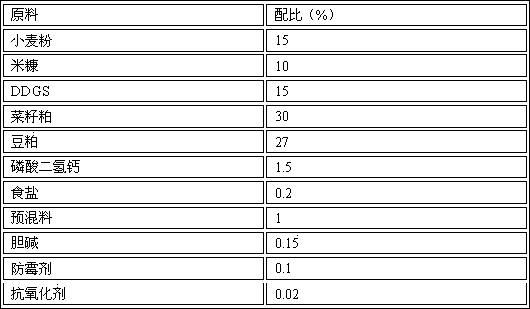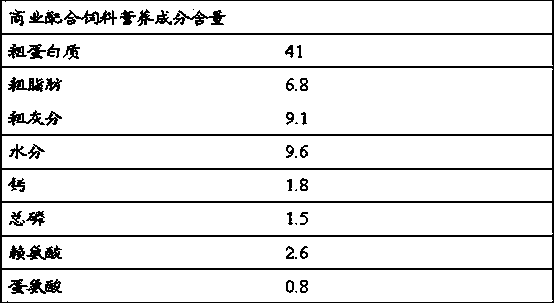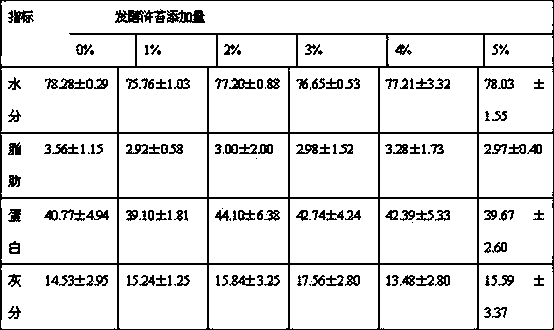Enteromorpha prolifera feed additive as well as preparation method and applications thereof
A feed additive and enteromorpha technology, applied in the field of feed additives, can solve problems such as complicated methods, low utilization rate of enteromorpha, inconvenient operation, etc.
- Summary
- Abstract
- Description
- Claims
- Application Information
AI Technical Summary
Problems solved by technology
Method used
Image
Examples
Embodiment 1
[0040] Embodiment 1: the preparation of feed additive
[0041] Enteromorpha collection and cleaning: From March to April 2012, enteromorpha raw materials were collected from various tidal flats in Jimei, Xiang'an, Tong'an, Xiamen Island, and Quanzhou Bay, filtered and rinsed with seawater, mud removed, brought back to the laboratory, and continued to use tap water Rinse 2 times.
[0042] Drying treatment of Enteromorpha: Drain the cleaned Enteromorpha, dry it in the air until there is no water drop left, put it in a 60°C oven and dry it until it can be manually crushed into small pieces;
[0043] Ultrafine pulverization of Enteromorpha: Use a low-temperature pulverizer at a temperature of 10°C to make algae powder from the small flakes of Enteromorpha after drying, and pass through a 60-mesh sieve to obtain Enteromorpha algae powder;
[0044]Anaerobic fermentation: Add 0.1% cellulase (Novozymes compound plant hydrolase ViscozymeL), 0.05% yeast powder (5 billion cfu / g) and 0.0...
Embodiment 2
[0046] Embodiment 2: aquaculture test
[0047] 1) Breeding experiment of Xingzhou red fish
[0048] Add 0%, 1%, 2%, 3%, and 4% to the commercial compound feed for Xingzhou red fish (tilapia compound feed purchased from Xiamen Yinxiang Feed Co., Ltd., see Table 1 and Table 2 for ingredients) , 5% fermented Enteromorpha, mixed evenly, using CD4×17S multifunctional catalytic molding machine to make granular feed with a particle size of 2.5mm, and fed with an average body weight of 4.69±1.98g and a body length of 5.16±0.63cm Sin Chew redfish seedlings. According to the addition amount of fermented Enteromorpha 1%, 2%, 3%, 4%, and 5%, the experiment was divided into 5 groups and a control group (addition amount was 0%), with 3 parallel fish in each group and 30 fish in each tank. The experiment period is 49 days. In the formal test, the feeding amount should be determined according to about 3% of the fish body weight, and adjusted according to the feeding situation. About 50%, ...
Embodiment 3
[0103] Embodiment 3: Feed Additive Orthogonal Test
[0104] Add different amounts of cellulase (Novozymes compound plant hydrolase ViscozymeL), yeast powder (5 billion cfu / g of Saccharomyces cerevisiae) and lactic acid bacteria powder (Lactobacillus acidophilus 3 billion cfu / g) to the enteromorpha algae powder ) (soak the bacterial powder for 4 hours before use) for orthogonal experiments, as shown in Table 13, each group was added with 70% water, mixed evenly, put into a fermentation bag with a specification of 350*450mm and a thickness of 10 silk, and sealed for fermentation 5 days, and determine the relevant indicators. Table 13 is the combination of orthogonal experiments under different conditions.
[0105] Table 13 Orthogonal experiment grouping:
[0106] factor A B C D 1 0 0 0 30 2 0 0.05 0.05 25 3 0 0.10 0.10 35 4 0.05 0 0.05 35 5 0.05 0.05 0.10 30 6 0.05 0.10 0 25 7 0.10 0 0.10 25 8 0.10 0.0...
PUM
| Property | Measurement | Unit |
|---|---|---|
| Particle size | aaaaa | aaaaa |
Abstract
Description
Claims
Application Information
 Login to View More
Login to View More - R&D
- Intellectual Property
- Life Sciences
- Materials
- Tech Scout
- Unparalleled Data Quality
- Higher Quality Content
- 60% Fewer Hallucinations
Browse by: Latest US Patents, China's latest patents, Technical Efficacy Thesaurus, Application Domain, Technology Topic, Popular Technical Reports.
© 2025 PatSnap. All rights reserved.Legal|Privacy policy|Modern Slavery Act Transparency Statement|Sitemap|About US| Contact US: help@patsnap.com



